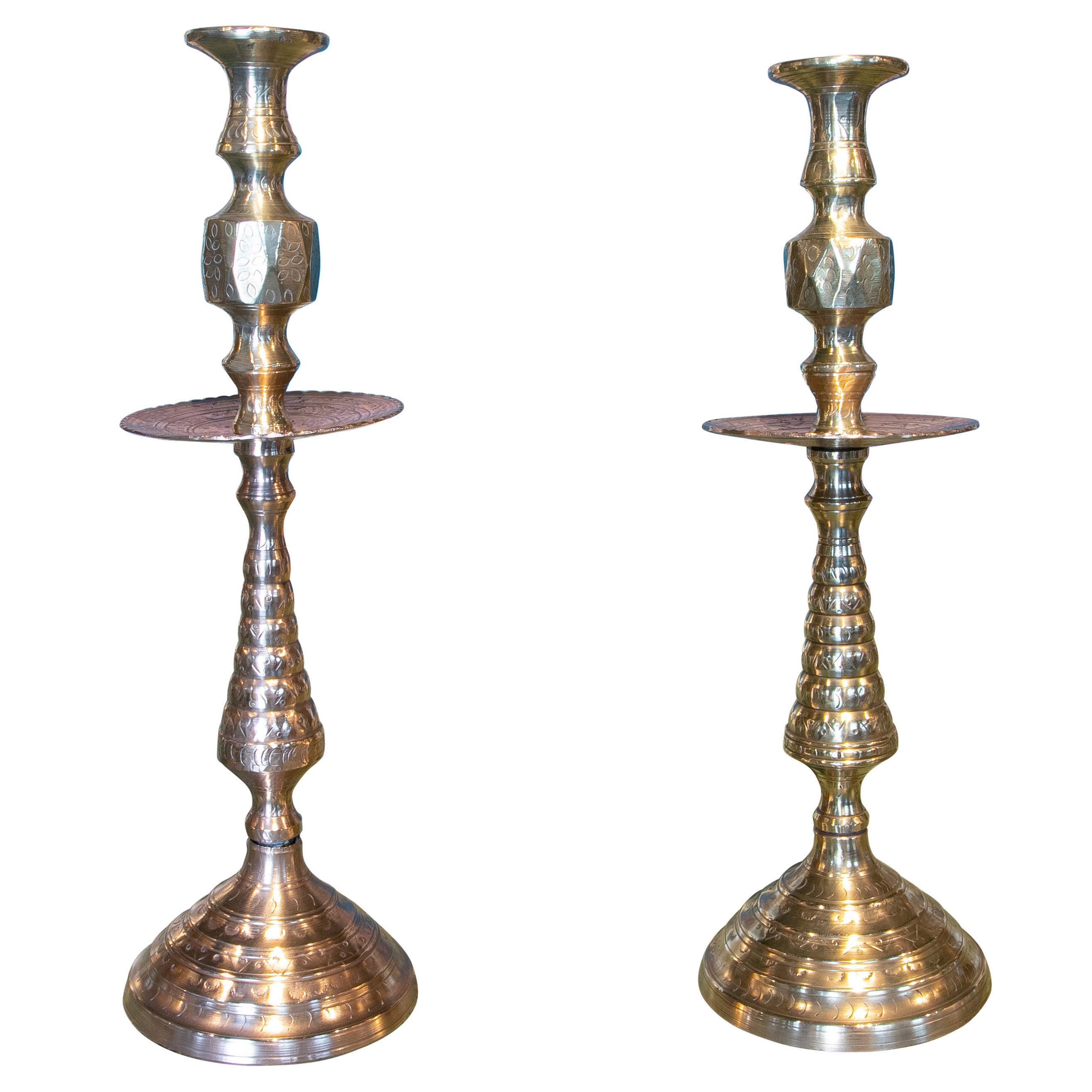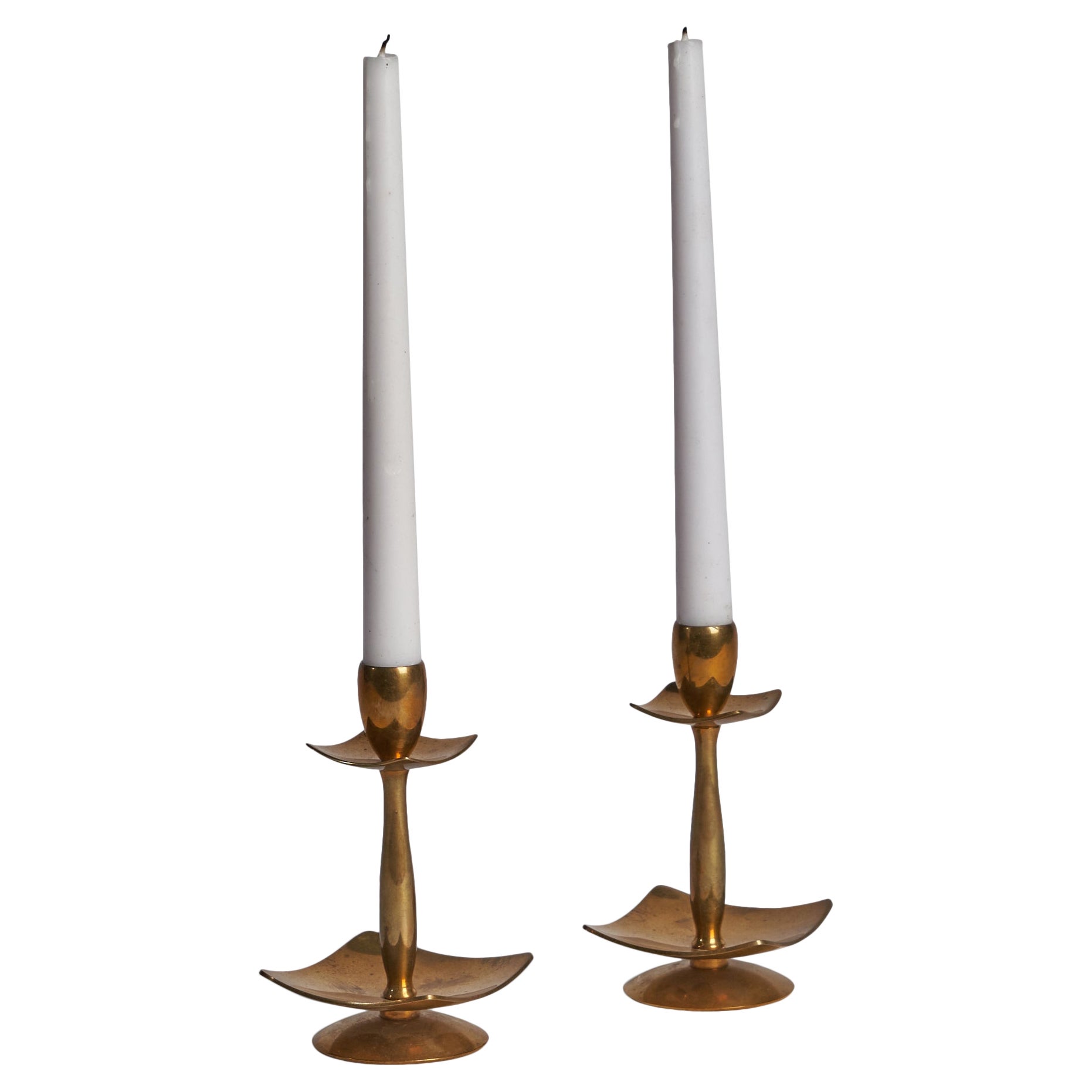Items Similar to Pair of Mid-Century Modernist Anodized Brass Lotus Candlesticks, USA, 1950s
Want more images or videos?
Request additional images or videos from the seller
1 of 8
Pair of Mid-Century Modernist Anodized Brass Lotus Candlesticks, USA, 1950s
About the Item
A duo of anodized brass candlesticks, each featuring a round base, stem and a lotus flower that contains a regular size candle. Manufactured in the USA during the 1960s.
The candlesticks are unpolished, bear the original vintage patina, and remain in excellent original vintage condition.
Dimensions:
Total height 8-3/4”
Lotus flower height 1-3/4”
Lotus flower diameter 3-1/4”
Base radius: 5-3/16”.
- Dimensions:Height: 8.75 in (22.23 cm)Diameter: 5.19 in (13.19 cm)
- Sold As:Set of 2
- Style:Mid-Century Modern (Of the Period)
- Materials and Techniques:Brass,Anodized
- Place of Origin:
- Period:
- Date of Manufacture:1950s
- Condition:Wear consistent with age and use. The candlesticks are unpolished, bear the original vintage patina, and remain in excellent original vintage condition. Please examine photos attentively, as they are an integral part of description.
- Seller Location:New York, NY
- Reference Number:1stDibs: LU2819313344071
About the Seller
5.0
Vetted Seller
These experienced sellers undergo a comprehensive evaluation by our team of in-house experts.
Established in 1993
1stDibs seller since 2017
68 sales on 1stDibs
Typical response time: 2 hours
- ShippingRetrieving quote...Ships From: New York, NY
- Return PolicyA return for this item may be initiated within 10 days of delivery.
More From This SellerView All
- WMF, German Jugenstil, a Pair of Copper & Brass Candlesticks, Ca. 1910By WMF IkoraLocated in New York, NYDETAILS Marked on bottom. WMF GmbH In 1853, mill owner Daniel Straub, together with the Schweizer brothers, Louis and Friedrich, established the Straub & Schweizer metal works in Geislingen an der Steige, Germany. Only a few years later in 1862, their silver-plated tableware and serving dishes were awarded a medal of distinction at the world exhibition in London. The company, originally called Metallwarenfabrik Straub & Schweizer, merged in 1880 with Ritter & Co - a producer of high end luxury items who were ahead of their time in silver plating technique. Instead of using the method of heat and mechanical pressure to plate their wares, Ritter dipped the item into a bath of silver which together with an electric current produced pieces that were finely and evenly covered in a layer of silver. This method of plating was called ‘Galvanisation’ and allowed more intricate and complex pieces to be plated. After several years both companies still faced financial problems and in 1880 they joined with the Wurttemberg Union Bank and the company was renamed “WMF” (Württembergische Metallwarenfabrik). From its founding as one company, WMF's growth was tremendous - acquiring more factories along the way, notably including "Orivit AG" and "Orion KM". By the end of the 1900's, they were the world's largest producer and exporter of household metalware. WMF started making glass in 1883 when a glass house was built at Geisslingen near Stuttgart to produce their own glass inserts. The original 1883 glass house was destroyed during the First World War and a new, more modern facility opened in 1922. The young glass designer Karl Wiedmann perfected the technique of iridized surfaces and the resulting "MYRA"- Kristall entered production in 1926. The same year also saw the beginning of the first "IKORA" glass - reputedly discovered by accident whilst correcting a Myra glass...Category
Vintage 1910s German Jugendstil Candlesticks
MaterialsBrass, Copper
- Aesthetic Movement Pair of Bronze Candlesticks in Manner of Tiffany, ca. 1880sLocated in New York, NYAmerican Aesthetic Movement Pair of Bronze Candlesticks in Manner of Tiffany ca. 1880s DIMENSIONS Height: 18.25 inches Width: 3.25 inches Depth: 3.25 inches ABOUT This elegant pa...Category
Antique 1880s American Aesthetic Movement Candlesticks
MaterialsBronze
- A Pair of Bronze Neoclassical Grand Tour Candelabras, Late 19th CenturyLocated in New York, NYGrand Tour Pair of Bronze Candelabras Late 19th Century DIMENSIONS Height: 10.33 inches Width: 4.75 inches Depth: 4.75 inches ABOUT We present to your attention a pair of stunning...Category
Antique 1890s English Grand Tour Candelabras
MaterialsBronze
- Pair of Japanese Patinated Bronze Candelabras, Meiji Period, ca. 1900Located in New York, NYThis most unusual pair of original 18th century Japanese patinated bronze candelabras, uniquely designed as branches of mountain flowers entangled by a dragon, are mounted on the con...Category
Antique Late 19th Century Japanese Japonisme Candelabras
MaterialsBronze
- Pair of American Rococo Revival Patinated Bronze Candelabras, Ca. 1825Located in New York, NYBronze, dark-brown patina, unmarked. Measures: Height: 23” Width: 14” The notion of an “American Rococo” seems a contradiction in terms. The very word rococo is as French as Camembert. It connotes a style that reigned along with Louis XV in the aristocratic decadence of the 18th Century. It was garlanded, nonchalant, associated with erotic marshmallow nudes by Francois Boucher and foppish courtiers costumed as shepherds pretending they understood Jean-Jacques Rousseau when all they really wanted was romantic dalliance in the formal gardens of Versailles. In the history of painting it produced but one great artist, Antoine Watteau. By contrast, Americans of the period are remembered as the flinty inheritors of New England Puritans, full of rectitude and having not a moment for furbelow or frippery. Such few painters as were around included hard-nosed realists like John Singleton Copley and Charles Willson Peale. Well, as it turns out, life once again acts according to the principle of paradox. There was an American rococo. It came to us indirectly via England disguised under the name Chippendale. Now for the first time the style receives comprehensive survey in the exhibition “American Rococo, 1750-1775: Elegance in Ornament.” Jointly organized by New York’s Metropolitan Museum and the Los Angeles County Museum of Art, it opens here Sundaywith a spread of some 170 works of decorative art and a conscientious catalogue with essays by Met and LACMA curators Morrison H. Heckscher and Leslie Greene Bowman. There are at least two ways of looking at the decorative arts. Connoisseurs appreciate their design and craftsmanship. Those of sociological bent examine objects of material culture for their revelations of history and the temper of the times. Actually neither view is complete without the other. Stylistically the rococo reveals a longing for intimacy in its small scale and an urge to organic nature in its love of stylized vines, tendrils, tiny flowers and seashells. If it were a new manner being promoted by Madison Avenue today it would probably be called “Baroque Lite.” There is an ease about the style that makes it airy, but it has an underlying formality that bespeaks lives of gentrified cultivation rather than beer-bellied sloth. It’s fascinating to examine the flintlock firearms on view and find these weapons of death shaped and decorated with the most exquisite care by wood carvers and metal engravers. All of this is completely consistent with the main currents of 18th-Century European thought. In France, Rousseau sang the virtues of nature and the noble savage like a present-day ecologist. In England, John Locke...Category
Antique 1820s American Rococo Revival Candelabras
MaterialsBronze
- A Pair of Art Deco Ceramic Candle Holders by Roockwood Pottery, ca. 1920By Rookwood Pottery Co.Located in New York, NYMARKINGS Each candle holder is fully marked on the bottom, including date XX (ca. 1920) and model number (2304). ROOCKWOOD POTTERY Roockwood is the synonym of the American Art Pottery. Founded on Thanksgiving Day in 1880 by Maria Longworth Storer, Rookwood made history – the first large manufacturing enterprise founded and owned by a woman in the United States and launching the art pottery movement in America. Within a decade, Rookwood pottery gained international acclaim, rivaling European and Asian firms that had been in existence for hundreds or thousands of years. Maria Longworth Nicholas, was the daughter of a wealthy art collector, she was inspired by Japanese pottery. When she discussed her desire to create fine pottery with her father, he provided the means and environment that allowed her to pursue her creative passions. And although it may have started as a hobby, the talented Maria quickly managed to establish Rookwood pottery as a quality producer of fine ceramic art potter. She setup the Rookwood company, hired artists like Japanese artist Kataro Shirayamadani who came to work for the company in 1887, and talented art students and encouraged them to use their creativity to experiment and create unique pottery pieces. Almost every piece designed by these artists sold for hundreds of dollars, and today they are regarded as highly collectible. A Rookwood piece by Japanese artist Kataro Shirayamadani sold for $198,000 in 1991. He was a Rookwood artist from 1887 until 1948. The Rookwood airbrush, called the mouth atomizer, was developed by Rookwood to apply glazes in an innovative way. The technique helped the company develop its own individual look. The atomizer helped add the beautiful layers of color Rookwood is known for, and the technique is still used at the Rookwood pottery today. More well-known pottery manufacturers and recognized artists doubted this female led company would have what it takes to succeed, but much to their surprise Rookwood turned out to be one of the best. By combining extraordinary attention to detail and innovative design Maria Longworth Nicholas made Rookwood the standard for ceramic pottery manufacturers to aim for. Today antique and vintage Rookwood Pottery...Category
Vintage 1920s American Art Deco Candlesticks
MaterialsCeramic
You May Also Like
- Brass Scandinavian Mid-Century Modern Candleholder Candlesticks, 1950sLocated in Reggio Emilia, ITScandinavian sphere candleholder candlestick in solid brass, Denmark, 1950s.Category
Vintage 1950s Danish Scandinavian Modern Candlesticks
MaterialsBrass
- Pair of Brass Lotus Candlesticks by FeldmanBy Feldman BrothersLocated in Palm Beach, FLVintage pair of candlesticks crafted in brass, with a bronze like patina, in a lotus form and mounted on classic round bases.Category
Mid-20th Century American Mid-Century Modern Candlesticks
MaterialsBrass
- 1950s Pair of Bronze CandlesticksLocated in Marbella, ES1950s pair of bronze candlesticks.Category
Antique 19th Century Spanish Candelabras
MaterialsBronze
- Mid Century Modern Vintage Brass Candlesticks Josef Frank Svenskt Tenn 1950sBy Svenskt Tenn, Josef FrankLocated in Vienna, ATMid Century Modern vintage candlesticks or candleholder attributed to Josef Frank for Svenskt Tenn 1950s Sweden from brass. An amazing candlestick from brass with curved circular li...Category
Late 20th Century Swedish Mid-Century Modern Candlesticks
MaterialsBrass
- Dantorp, Candlesticks, Brass, Denmark, 1950sLocated in High Point, NCA pair of brass candlesticks designed and produced by Dantorp Design, Denmark, c. 1950s. Fits 0.45” & 0.80” diameter candlesCategory
Vintage 1950s Danish Mid-Century Modern Candlesticks
MaterialsBrass
- Dantorp, Candlesticks, Brass, Denmark, 1950sLocated in High Point, NCA pair of brass candlesticks designed and produced by Dantorp, Denmark, 1950s. Fits 0.75” & 0.45” diameter candlesCategory
Vintage 1950s Danish Mid-Century Modern Candlesticks
MaterialsBrass
Recently Viewed
View AllMore Ways To Browse
Mid Century Usa
20Th Mid Century Candlesticks
20th Century Brass Candlesticks
Brass Mid Century Candlesticks
Pair Of Vintage Brass Candlesticks
Mid Century Brass Candlesticks
Midcentury Brass Candlesticks
Lotus Pair
Pair Of Vintage Brass Candlesticks Candlesticks Holders
Midcentury Modern Brass Candlesticks
Mid Century Modern Brass Candlestick
Brass Lotus
Flower Candlestick
3 Mid Century Candle
Vintage Mid Century Candlesticks
Pair Of Midcentury Brass Candlesticks
Brass Candlesticks 1950s
Brass Flower Holder





